1、导包
import unittest
2、创建测试类
1)定义类:
编写规范 • 测试模块⾸先 import unittest! • 测试类必须继承 unittest.TestCase! • 测试⽅法必须以“test_”开头! • 模块名字,类名没有要求
class 类名(unittest.TestCase)
import unittest class Reg(unittest.TestCase):
2)创建初始化和还原环境的函数

例如
# 在所有测试函数之前运行一次 @classmethod def setUpClass(cls): print("在所有测试函数之前运行一次") # 所有测试函数运行完后运行一次 @classmethod def tearDownClass(cls): print("所有测试函数运行完后运行一次") # 每个测试函数运行前运行 def setUp(self): print("每个测试函数运行前运行") # 每个测试函数运行完后执行 def tearDown(self): print("每个测试函数运行完后执行")
3)测试函数

例如
# 测试方法一 def testMethod1(self): print("测试方法一")
4)运行测试

# 运行测试 if __name__=="__main__": unittest.main(verbosity=2)
完整代码
import unittest driver =None; class Reg(unittest.TestCase): # 在所有测试函数之前运行一次 @classmethod def setUpClass(cls): print("在所有测试函数之前运行一次") # 所有测试函数运行完后运行一次 @classmethod def tearDownClass(cls): print("所有测试函数运行完后运行一次") # 每个测试函数运行前运行 def setUp(self): print("每个测试函数运行前运行") # 每个测试函数运行完后执行 def tearDown(self): print("每个测试函数运行完后执行") # 测试方法一 def testMethod1(self): print("测试方法一") # 测试方法二、 def testMethod2(self): print("测试方法二") # 运行测试 if __name__=="__main__": unittest.main(verbosity=2)
3、断言
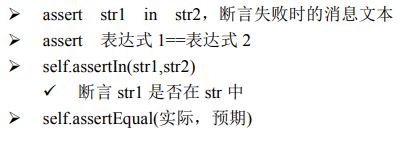
assert "ab" in "abc" assert "abhhh" in "abc" assert "ab"=="abc" self.assertIn("ab","abc") self.assertIn("abjjjj","abc")
4、参数化
1)安装
nose_parameterized
链接:https://pan.baidu.com/s/1g0n6_94zU-E1FsHxS18kLQ
提取码:g7v7
2)导包
import parameterized
3)定义参数数据
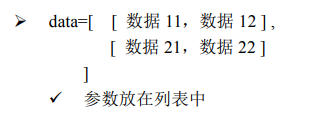
4)引用参数
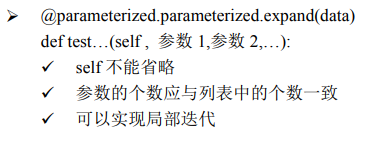
参数化代码:
import unittest import parameterized data=[["zs",12],["ls",13],["zs",33]]
class Reg(unittest.TestCase): # 在所有测试函数之前运行一次 @classmethod def setUpClass(cls): print("在所有测试函数之前运行一次") # 所有测试函数运行完后运行一次 @classmethod def tearDownClass(cls): print("所有测试函数运行完后运行一次") # 每个测试函数运行前运行 def setUp(self): print("每个测试函数运行前运行") # 每个测试函数运行完后执行 def tearDown(self): print("每个测试函数运行完后执行") # 测试方法一 def testMethod1(self): print("测试方法一") # 测试方法二、 @parameterized.parameterized.expand(data) def testMethod2(self, name, age): print(name+"---"+str(age)) # 运行测试 if __name__=="__main__": unittest.main(verbosity=2)
5、测试套件
1 )指定运行一个模块中的一个测试
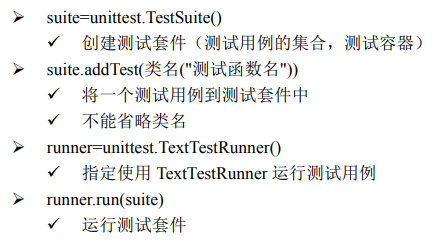
测试套件使用:
import unittestfrom test01 import test # 创建测试套件 suite = unittest.TestSuite() # 测试单个方法 suite.addTest(test("test1add")) runner = unittest.TextTestRunner() runner.run(suite)
2) 指定按顺序运行一个模块中的多个测试
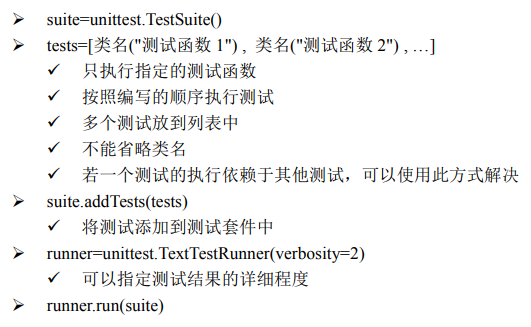
使用:
import unittest
import time
from test01 import test
# 创建测试套件
suite = unittest.TestSuite()
# 测试多个方法 tests = [test("test1add"),test("test2add"),test("test3Select")] suite.addTests(tests) runner = unittest.TextTestRunner() runner.run(suite)
3 )自动发现多个测试

使用:
import unittest
# 创建测试套件 suite = unittest.TestSuite() # 自动发现多个测试 tests = unittest.defaultTestLoader.discover("./",pattern="web*.py") suite.addTests(tests) runner = unittest.TextTestRunner(verbosity=2) runner.run(suite)
6 、测试报告
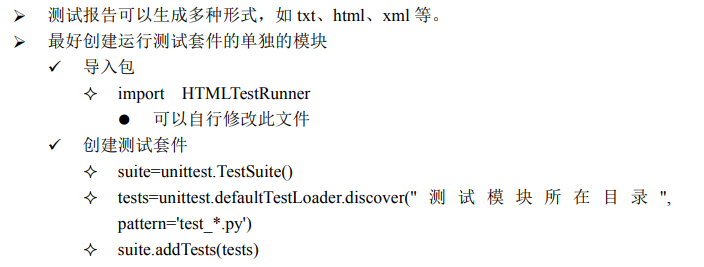

使用:
import unittest import time import os import HTMLTestRunner # 创建测试套件 suite = unittest.TestSuite() # 自动发现多个测试 tests = unittest.defaultTestLoader.discover("./",pattern="web*.py") suite.addTests(tests) runner = unittest.TextTestRunner(verbosity=2)
#测试报告存放位置
report_path = os.path.join(os.path.dirname(__file__),'report') # 获取当前时间 now = time.strftime("%Y%m%d %H%M%S",time.localtime()) # 测试报告存放位置以及命名规则 reportFile = report_path + "/"+now+"_result.html" fp = open(reportFile,'wb') runner = HTMLTestRunner.HTMLTestRunner(stream=fp,title=u'报告标题功能测试报告', description=u'报告的说明与描述', tester=u'测试员姓名') runner.run(suite) fp.close()
HTMLTestRunner

""" A TestRunner for use with the Python unit testing framework. It generates a HTML report to show the result at a glance. The simplest way to use this is to invoke its main method. E.g. import unittest import HTMLTestRunner ... define your tests ... if __name__ == '__main__': HTMLTestRunner.main() For more customization options, instantiates a HTMLTestRunner object. HTMLTestRunner is a counterpart to unittest's TextTestRunner. E.g. # output to a file fp = file('my_report.html', 'wb') runner = HTMLTestRunner.HTMLTestRunner( stream=fp, title='My unit test', description='This demonstrates the report output by HTMLTestRunner.' ) # Use an external stylesheet. # See the Template_mixin class for more customizable options runner.STYLESHEET_TMPL = '<link rel="stylesheet" href="my_stylesheet.css" type="text/css">' # run the test runner.run(my_test_suite) ------------------------------------------------------------------------ Copyright (c) 2004-2007, Wai Yip Tung All rights reserved. Redistribution and use in source and binary forms, with or without modification, are permitted provided that the following conditions are met: * Redistributions of source code must retain the above copyright notice, this list of conditions and the following disclaimer. * Redistributions in binary form must reproduce the above copyright notice, this list of conditions and the following disclaimer in the documentation and/or other materials provided with the distribution. * Neither the name Wai Yip Tung nor the names of its contributors may be used to endorse or promote products derived from this software without specific prior written permission. THIS SOFTWARE IS PROVIDED BY THE COPYRIGHT HOLDERS AND CONTRIBUTORS "AS IS" AND ANY EXPRESS OR IMPLIED WARRANTIES, INCLUDING, BUT NOT LIMITED TO, THE IMPLIED WARRANTIES OF MERCHANTABILITY AND FITNESS FOR A PARTICULAR PURPOSE ARE DISCLAIMED. IN NO EVENT SHALL THE COPYRIGHT OWNER OR CONTRIBUTORS BE LIABLE FOR ANY DIRECT, INDIRECT, INCIDENTAL, SPECIAL, EXEMPLARY, OR CONSEQUENTIAL DAMAGES (INCLUDING, BUT NOT LIMITED TO, PROCUREMENT OF SUBSTITUTE GOODS OR SERVICES; LOSS OF USE, DATA, OR PROFITS; OR BUSINESS INTERRUPTION) HOWEVER CAUSED AND ON ANY THEORY OF LIABILITY, WHETHER IN CONTRACT, STRICT LIABILITY, OR TORT (INCLUDING NEGLIGENCE OR OTHERWISE) ARISING IN ANY WAY OUT OF THE USE OF THIS SOFTWARE, EVEN IF ADVISED OF THE POSSIBILITY OF SUCH DAMAGE. """ '''# URL: http://tungwaiyip.info/software/HTMLTestRunner.html''' __author__ = "Keynes zhao" __version__ = "0.8.2" """ Change History Version 0.8.2 * Show output inline instead of popup window (Viorel Lupu). Version in 0.8.1 * Validated XHTML (Wolfgang Borgert). * Added description of test classes and test cases. Version in 0.8.0 * Define Template_mixin class for customization. * Workaround a IE 6 bug that it does not treat <script> block as CDATA. Version in 0.7.1 * Back port to Python 2.3 (Frank Horowitz). * Fix missing scroll bars in detail log (Podi). """ # TODO: color stderr # TODO: simplify javascript using ,ore than 1 class in the class attribute? import datetime import io import sys import time import unittest from xml.sax import saxutils # ------------------------------------------------------------------------ # The redirectors below are used to capture output during testing. Output # sent to sys.stdout and sys.stderr are automatically captured. However # in some cases sys.stdout is already cached before HTMLTestRunner is # invoked (e.g. calling logging.basicConfig). In order to capture those # output, use the redirectors for the cached stream. # # e.g. # >>> logging.basicConfig(stream=HTMLTestRunner.stdout_redirector) # >>> class OutputRedirector(object): """ Wrapper to redirect stdout or stderr """ def __init__(self, fp): self.fp = fp def write(self, s): self.fp.write(s) def writelines(self, lines): self.fp.writelines(lines) def flush(self): self.fp.flush() stdout_redirector = OutputRedirector(sys.stdout) stderr_redirector = OutputRedirector(sys.stderr) # ---------------------------------------------------------------------- # Template class Template_mixin(object): """ Define a HTML template for report customerization and generation. Overall structure of an HTML report HTML +------------------------+ |<html> | | <head> | | | | STYLESHEET | | +----------------+ | | | | | | +----------------+ | | | | </head> | | | | <body> | | | | HEADING | | +----------------+ | | | | | | +----------------+ | | | | REPORT | | +----------------+ | | | | | | +----------------+ | | | | ENDING | | +----------------+ | | | | | | +----------------+ | | | | </body> | |</html> | +------------------------+ """ STATUS = { 0: '通过', 1: '失败', 2: '错误', } DEFAULT_TITLE = '测试报告' DEFAULT_DESCRIPTION = '' DEFAULT_TESTER = '测试工程师' # ------------------------------------------------------------------------ # HTML Template HTML_TMPL = r"""<?xml version="1.0" encoding="UTF-8"?> <!DOCTYPE html PUBLIC "-//W3C//DTD XHTML 1.0 Strict//EN" "http://www.w3.org/TR/xhtml1/DTD/xhtml1-strict.dtd"> <html xmlns="http://www.w3.org/1999/xhtml"> <head> <title>%(title)s</title> <meta name="generator" content="%(generator)s"/> <meta http-equiv="Content-Type" content="text/html; charset=UTF-8"/> %(stylesheet)s </head> <body> <script language="javascript" type="text/javascript"><!-- output_list = Array(); /* level - 0:Summary; 1:Failed; 2:All */ function showCase(level) { trs = document.getElementsByTagName("tr"); for (var i = 0; i < trs.length; i++) { tr = trs[i]; id = tr.id; if (id.substr(0,2) == 'ft') { if (level < 1) { tr.className = 'hiddenRow'; } else { tr.className = ''; } } if (id.substr(0,2) == 'pt') { if (level > 1) { tr.className = ''; } else { tr.className = 'hiddenRow'; } } } //加入【详细信息】切换文字变化 --Findyou detail_class=document.getElementsByClassName('detail'); //console.log(detail_class.length) if (level == 3) { for (var i = 0; i < detail_class.length; i++){ detail_class[i].innerHTML="收起"; } } else{ for (var i = 0; i < detail_class.length; i++){ detail_class[i].innerHTML="详细信息"; } } } function showClassDetail(cid, count) { var id_list = Array(count); var toHide = 1; for (var i = 0; i < count; i++) { tid0 = 't' + cid.substr(1) + '.' + (i+1); tid = 'f' + tid0; tr = document.getElementById(tid); if (!tr) { tid = 'p' + tid0; tr = document.getElementById(tid); } id_list[i] = tid; if (tr.className) { toHide = 0; } } for (var i = 0; i < count; i++) { tid = id_list[i]; //修改点击无法收起的BUG,加入【详细信息】切换文字变化 --Findyou if (toHide) { document.getElementById(tid).className = 'hiddenRow'; document.getElementById(cid).innerText = "详细信息" } else { document.getElementById(tid).className = ''; document.getElementById(cid).innerText = "收起" } } } function showTestDetail(div_id){ var details_div = document.getElementById(div_id) var displayState = details_div.style.display; // alert(displayState) if (displayState != 'block' ) { displayState = 'block'; details_div.style.display = 'block'; } else { details_div.style.display = 'none'; } } function html_escape(s) { s = s.replace(/&/g,'&'); s = s.replace(/</g,'<'); s = s.replace(/>/g,'>'); return s; } /* obsoleted by detail in <div> function showOutput(id, name) { var w = window.open("", //url name, "resizable,scrollbars,status,width=800,height=450"); d = w.document; d.write("<pre>"); d.write(html_escape(output_list[id])); d.write(" "); d.write("<a href='javascript:window.close()'>close</a> "); d.write("</pre> "); d.close(); } */ --></script> %(heading)s %(report)s %(ending)s </body> </html> """ # variables: (title, generator, stylesheet, heading, report, ending) # ------------------------------------------------------------------------ # Stylesheet # # alternatively use a <link> for external style sheet, e.g. # <link rel="stylesheet" href="$url" type="text/css"> STYLESHEET_TMPL = """ <style type="text/css" media="screen"> body { font-family: verdana, arial, helvetica, sans-serif; font-size: 80%; } table { font-size: 100%; } pre { } /* -- heading ---------------------------------------------------------------------- */ h1 { font-size: 16pt; color: gray; } .heading { margin-top: 0ex; margin-bottom: 1ex; } .heading .attribute { margin-top: 1ex; margin-bottom: 0; } .heading .description { margin-top: 4ex; margin-bottom: 6ex; } /* -- css div popup ------------------------------------------------------------------------ */ a.popup_link { } a.popup_link:hover { color: red; } .popup_window { display: none; position: relative; left: 0px; top: 0px; /*border: solid #627173 1px; */ padding: 10px; background-color: #E6E6D6; font-family: "Lucida Console", "Courier New", Courier, monospace; text-align: left; font-size: 8pt; 500px; } } /* -- report ------------------------------------------------------------------------ */ #show_detail_line { margin-top: 3ex; margin-bottom: 1ex; } #result_table { 80%; border-collapse: collapse; border: 1px solid #777; } #header_row { font-weight: bold; color: white; background-color: #777; } #result_table td { border: 1px solid #777; padding: 2px; } #total_row { font-weight: bold; } .passClass { background-color: #6c6; } .failClass { background-color: #c60; } .errorClass { background-color: #c00; } .passCase { color: #6c6; } .failCase { color: #c60; font-weight: bold; } .errorCase { color: #c00; font-weight: bold; } .hiddenRow { display: none; } .testcase { margin-left: 2em; } /* -- ending ---------------------------------------------------------------------- */ #ending { } </style> """ # ------------------------------------------------------------------------ # Heading # HEADING_TMPL = """<div class='heading'><h1>%(title)s</h1>%(parameters)s<p class='description'><h1>%(description)s</h1></p></div>""" # variables: (title, parameters, description) HEADING_ATTRIBUTE_TMPL = """<p class='attribute'><strong>%(name)s:</strong> %(value)s</p>""" # variables: (name, value) # ------------------------------------------------------------------------ # Report # REPORT_TMPL = """ <table id='result_table'> <colgroup> <col align='left' /> <col align='right' /> <col align='right' /> <col align='right' /> <col align='right' /> <col align='right' /> </colgroup> <tr id='header_row'> <td>测试用例</td> <td>总计</td> <td>通过</td> <td>失败</td> <td>错误</td> <td>查看</td> </tr> %(test_list)s <tr id='total_row'> <td>总计</td> <td>%(count)s</td> <td>%(Pass)s</td> <td>%(fail)s</td> <td>%(error)s</td> <td> </td> </tr> </table> """ # variables: (test_list, count, Pass, fail, error) REPORT_CLASS_TMPL = r""" <tr class='%(style)s'> <td>%(desc)s</td> <td>%(count)s</td> <td>%(Pass)s</td> <td>%(fail)s</td> <td>%(error)s</td> <td><a href="javascript:showClassDetail('%(cid)s',%(count)s)" class="detail" id='%(cid)s'>详细信息</a></td> </tr> """ # variables: (style, desc, count, Pass, fail, error, cid) REPORT_TEST_WITH_OUTPUT_TMPL = r""" <tr id='%(tid)s' class='%(Class)s'> <td class='%(style)s'><div class='testcase'>%(desc)s</div></td> <td colspan='5' align='center'> <!--css div popup start--> <a class="popup_link" onfocus='this.blur();' href="javascript:showTestDetail('div_%(tid)s')" > %(status)s</a> <div id='div_%(tid)s' class="popup_window"> <div style='text-align: right; color:red;cursor:pointer'> <a onfocus='this.blur();' onclick="document.getElementById('div_%(tid)s').style.display = 'none' " > [x]</a> </div> <pre> %(script)s </pre> </div> <!--css div popup end--> </td> </tr> """ # variables: (tid, Class, style, desc, status) REPORT_TEST_NO_OUTPUT_TMPL = r""" <tr id='%(tid)s' class='%(Class)s'> <td class='%(style)s'><div class='testcase'>%(desc)s</div></td> <td colspan='5' align='center'>%(status)s</td> </tr> """ # variables: (tid, Class, style, desc, status) REPORT_TEST_OUTPUT_TMPL = r""" %(id)s: %(output)s """ # variables: (id, output) # ------------------------------------------------------------------------ # ENDING # ENDING_TMPL = """<div id='ending'> </div>""" # -------------------- The end of the Template class ------------------- TestResult = unittest.TestResult class _TestResult(TestResult): # note: _TestResult is a pure representation of results. # It lacks the output and reporting ability compares to unittest._TextTestResult. def __init__(self, verbosity=1): TestResult.__init__(self) self.stdout0 = None self.stderr0 = None self.success_count = 0 self.failure_count = 0 self.error_count = 0 self.verbosity = verbosity # result is a list of result in 4 tuple # ( # result code (0: success; 1: fail; 2: error), # TestCase object, # Test output (byte string), # stack trace, # ) self.result = [] #增加一个测试通过率 --Findyou self.passrate=float(0) def startTest(self, test): TestResult.startTest(self, test) # just one buffer for both stdout and stderr self.outputBuffer = io.BytesIO() stdout_redirector.fp = self.outputBuffer stderr_redirector.fp = self.outputBuffer self.stdout0 = sys.stdout self.stderr0 = sys.stderr sys.stdout = stdout_redirector sys.stderr = stderr_redirector def complete_output(self): """ Disconnect output redirection and return buffer. Safe to call multiple times. """ if self.stdout0: sys.stdout = self.stdout0 sys.stderr = self.stderr0 self.stdout0 = None self.stderr0 = None return self.outputBuffer.getvalue() def stopTest(self, test): # Usually one of addSuccess, addError or addFailure would have been called. # But there are some path in unittest that would bypass this. # We must disconnect stdout in stopTest(), which is guaranteed to be called. self.complete_output() def addSuccess(self, test): self.success_count += 1 TestResult.addSuccess(self, test) output = self.complete_output() self.result.append((0, test, output, '')) if self.verbosity > 1: sys.stderr.write('ok ') sys.stderr.write(str(test)) sys.stderr.write(' ') else: sys.stderr.write('.') def addError(self, test, err): self.error_count += 1 TestResult.addError(self, test, err) _, _exc_str = self.errors[-1] output = self.complete_output() self.result.append((2, test, output, _exc_str)) if self.verbosity > 1: sys.stderr.write('E ') sys.stderr.write(str(test)) sys.stderr.write(' ') else: sys.stderr.write('E') def addFailure(self, test, err): self.failure_count += 1 TestResult.addFailure(self, test, err) _, _exc_str = self.failures[-1] output = self.complete_output() self.result.append((1, test, output, _exc_str)) if self.verbosity > 1: sys.stderr.write('F ') sys.stderr.write(str(test)) sys.stderr.write(' ') else: sys.stderr.write('F') class HTMLTestRunner(Template_mixin): """ """ def __init__(self, stream=sys.stdout, verbosity=1, title=None, description=None,tester=None): self.stream = stream self.verbosity = verbosity if title is None: self.title = self.DEFAULT_TITLE else: self.title = title if description is None: self.description = self.DEFAULT_DESCRIPTION else: self.description = description if tester is None: self.tester = self.DEFAULT_TESTER else: self.tester = tester self.startTime = datetime.datetime.now() def run(self, test): "Run the given test case or test suite." result = _TestResult(self.verbosity) test(result) self.stopTime = datetime.datetime.now() self.generateReport(test, result) print(sys.stderr, ' Time Elapsed: %s' % (self.stopTime-self.startTime)) return result def sortResult(self, result_list): # unittest does not seems to run in any particular order. # Here at least we want to group them together by class. rmap = {} classes = [] for n,t,o,e in result_list: cls = t.__class__ if not cls in rmap: rmap[cls] = [] classes.append(cls) rmap[cls].append((n,t,o,e)) r = [(cls, rmap[cls]) for cls in classes] return r def getReportAttributes(self, result): """ Return report attributes as a list of (name, value). Override this to add custom attributes. """ startTime = str(self.startTime)[:19] duration = str(self.stopTime - self.startTime) status = [] if result.success_count: status.append('通过用例数 %s' % result.success_count) if result.failure_count: status.append('失败用例数 %s' % result.failure_count) if result.error_count: status.append('错误数 %s' % result.error_count) if status: status = ','.join(status) self.passrate = str("%.2f%%" % (float(result.success_count) / float(result.success_count + result.failure_count + result.error_count) * 100)) else: status = 'none' return [ ('测试人员', self.tester), ('开始时间',startTime), ('合计耗时',duration), ('测试结果',status + ",通过率 "+self.passrate), ] def generateReport(self, test, result): report_attrs = self.getReportAttributes(result) generator = 'HTMLTestRunner %s' % __version__ stylesheet = self._generate_stylesheet() heading = self._generate_heading(report_attrs) report = self._generate_report(result) ending = self._generate_ending() output = self.HTML_TMPL % dict( title = saxutils.escape(self.title), generator = generator, stylesheet = stylesheet, heading = heading, report = report, ending = ending, ) self.stream.write(output.encode('utf8')) def _generate_stylesheet(self): return self.STYLESHEET_TMPL def _generate_heading(self, report_attrs): a_lines = [] for name, value in report_attrs: line = self.HEADING_ATTRIBUTE_TMPL % dict( name = saxutils.escape(name), value = saxutils.escape(value), ) a_lines.append(line) heading = self.HEADING_TMPL % dict( title = saxutils.escape(self.title), parameters = ''.join(a_lines), description = saxutils.escape(self.description), ) return heading def _generate_report(self, result): rows = [] sortedResult = self.sortResult(result.result) for cid, (cls, cls_results) in enumerate(sortedResult): # subtotal for a class np = nf = ne = 0 for n,t,o,e in cls_results: if n == 0: np += 1 elif n == 1: nf += 1 else: ne += 1 # format class description if cls.__module__ == "__main__": name = cls.__name__ else: name = "%s.%s" % (cls.__module__, cls.__name__) doc = cls.__doc__ and cls.__doc__.split(" ")[0] or "" desc = doc and '%s: %s' % (name, doc) or name row = self.REPORT_CLASS_TMPL % dict( style = ne > 0 and 'errorClass' or nf > 0 and 'failClass' or 'passClass', desc = desc, count = np+nf+ne, Pass = np, fail = nf, error = ne, cid = 'c%s' % (cid+1), ) rows.append(row) for tid, (n,t,o,e) in enumerate(cls_results): self._generate_report_test(rows, cid, tid, n, t, o, e) report = self.REPORT_TMPL % dict( test_list = ''.join(rows), count = str(result.success_count+result.failure_count+result.error_count), Pass = str(result.success_count), fail = str(result.failure_count), error = str(result.error_count), passrate =self.passrate, ) return report def _generate_report_test(self, rows, cid, tid, n, t, o, e): # e.g. 'pt1.1', 'ft1.1', etc has_output = bool(o or e) tid = (n == 0 and 'p' or 'f') + 't%s.%s' % (cid+1,tid+1) name = t.id().split('.')[-1] doc = t.shortDescription() or "" desc = doc and ('%s: %s' % (name, doc)) or name tmpl = has_output and self.REPORT_TEST_WITH_OUTPUT_TMPL or self.REPORT_TEST_NO_OUTPUT_TMPL # o and e should be byte string because they are collected from stdout and stderr? if isinstance(o,str): # TODO: some problem with 'string_escape': it escape and mess up formating # uo = unicode(o.encode('string_escape')) uo = o.decode('latin-1') else: uo = o if isinstance(e,str): # TODO: some problem with 'string_escape': it escape and mess up formating # ue = unicode(e.encode('string_escape')) ue = e else: ue = e script = self.REPORT_TEST_OUTPUT_TMPL % dict( id = tid, output = saxutils.escape(str(uo)+ue), ) row = tmpl % dict( tid = tid, Class = (n == 0 and 'hiddenRow' or 'none'), style = n == 2 and 'errorCase' or (n == 1 and 'failCase' or 'none'), desc = desc, script = script, status = self.STATUS[n], ) rows.append(row) if not has_output: return def _generate_ending(self): return self.ENDING_TMPL ############################################################################## # Facilities for running tests from the command line ############################################################################## # Note: Reuse unittest.TestProgram to launch test. In the future we may # build our own launcher to support more specific command line # parameters like test title, CSS, etc. class TestProgram(unittest.TestProgram): """ A variation of the unittest.TestProgram. Please refer to the base class for command line parameters. """ def runTests(self): # Pick HTMLTestRunner as the default test runner. # base class's testRunner parameter is not useful because it means # we have to instantiate HTMLTestRunner before we know self.verbosity. if self.testRunner is None: self.testRunner = HTMLTestRunner(verbosity=self.verbosity) unittest.TestProgram.runTests(self) main = TestProgram ############################################################################## # Executing this module from the command line ############################################################################## if __name__ == "__main__": main(module=None)
#测试报告存放文件夹
report_path = os.path.join(os.path.dirname(__file__),'report')
